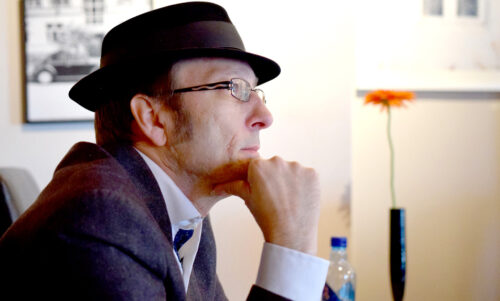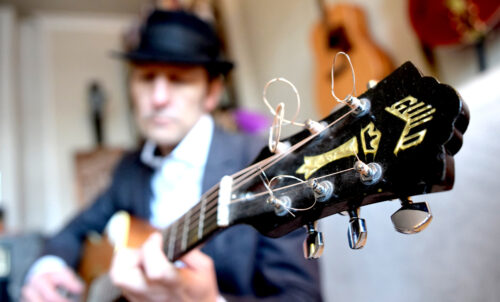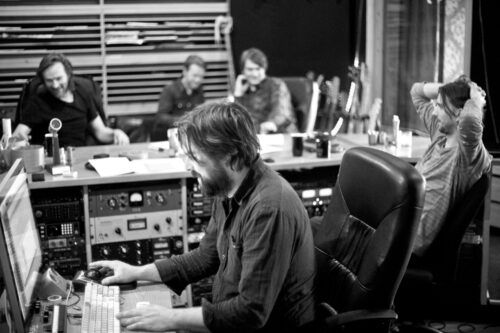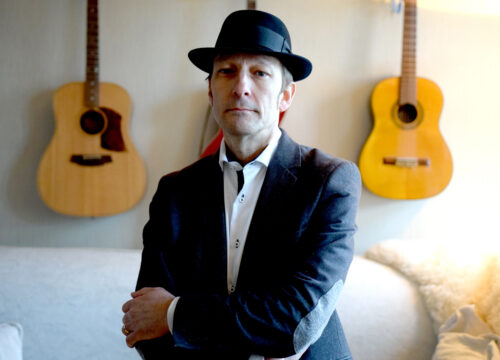That’s the title of Tom Roger Aadland’s new album, a collection of songs that has gathered quite some critical praise lately. We’ve had a long and deep conversation with the rock poet about songwriting, studio magic, the releasing power of Dylan and much more.
“Pretty close to a masterpiece”, Fædrelandsvennen writes about Tom Roger Aadland’s new album “Rapport frå eit grensehotell”. Dagsavisen calles it “bordering on genius”. It’s not the first time the 50 year old from Vikebygd outside of Haugesund gets good reviews, but it hasn’ flattered away his modesty.
– No, this time I especially appreciate the good reviews. Partly because this album to a great extent got just the expression we were going for production-wise. In addition I’ve largely followed my gut feeling when I wrote the songs. If this hadn’t happened, I would really be in the fog. Now, perhaps I’m in the highlands, he says with a dry smile.
Grown men in minor
Aadland’s reputation as a storyteller and interpreter of songs has spread among musical connoisseurs over the last years. He hasn’t enjoyed the same commercial breakthrough as, say, Stein Torleif Bjella, but that could easily change. Old weather-beaten Norway has always been receptive to mature, solemn men with a guitar, melodies in minor and stories that don’t try to hide that life is a dance on thorns rather than roses.
Just think about Cash, Cohen or Dylan – or more local names like Eidsvåg, Høyem or Bjella. Tom Roger Aadland naturally belongs in this company. He has his late debut in common with Bjella. The latter’s solo debut was at 41. Aadland was two years older.

– I’ve always thought there is something unique in the marriage between rock and poetry. I’ve got one foot in both camps, and I find that meeting point a gratifying place to be, says Tom Roger Aadland. (Photo: Adeel Muhammad/TONO)
Van Morrison’s mixing console and the releasing power of Dylan
We’re sitting at the cafe “Lyst” at Tøyen in Oslo, where Aadland lives. He combines the interview with lunch. The soup will get cold during our conversation. Aadland likes talking about songwriting. There’s not much time for eating.
– It took me a while, yes. Music got a grip on me even I was a child at Sunday School, then I found rock and the classical guitar, he tells. The guitar lessons eventually led to a formal higher education in classical guitar at the Conservatory of Music in Oslo. After that he was employed as a guitar teacher for fifteen years until rock came knocking on his door once again. The Bach fugues were deported to Aadland’s hobby sphere. Now he’s made a living from his folk rock for 10 years.
It started with the album “Obviously Embraced” in 2007, recorded in Ireland with Irish musicians and mixed by Van Morrison’s engineer at the Northern Irish soul master’s own mixing console. So the debut album was in English. He explains that by coming from the southwest of Norway with a short way overseas. But on his second album “Blod på spora” from 2009, Norwegian was what mattered. Here Aadland took on Dylan’s classic album “Blood on the Tracks”. All songs recorded in Norwegian. Some called it brave: The elevated Dylan has disciples with a more fanatic attitude towards Dylan’s songs than the master himself. Aadland says it never struck him. It was simply a labour of love.
– Did Dylan inspire you into writing in Norwegian?
– Something was released in me. Rock in Norwegian Nynorsk hasn’t been explored a lot, and it’s fine for the archaic element in Dylan’s lyrics, Aadland says. He is now very comfortable with Norwegian Nynorsk as a “working language”.
– I like the combination of the archaic with the rougher everyday expressions. It gives you an opportunity to create something with its own character.
Rock poet
Norwegian Nynorsk followed along on the albums “Det du aldri sa” (2011) and “Fløyel og stål” (2012). All praised by the critics, among them the national radio program “Norsk på norsk”. Is he mostly rock or mostly a poet?
– Most of the lyrics on “Rapport…” were written before the melodies. That’s a new method for me. But I’ve always felt there is something unique in the marriage between rock and poetry. It has its own set of rules. Take Lou Reed. He is a great poet, but it wouldn’t work without the music. I’ve got one foot in each camp, and I find that meeting point a gratifying place to be.

Tom Roger Aadland has been a member of TONO since 1985 and has 90 songs registered here. With the new album “Rapport frå eit grensehotell” he has released his fifth album in eight years. (Photo: Adeel Muhammad/TONO)
Borrows from life lived
There are pictures of war in the title track on the new album. You could be deceived into thinking that the writer takes on the role of a calmly observant correspondent in his lyrics, unmarked by the content of the observations. But no. Eidsvåg was mentioned previously in this article. There is a relation there. The album contains 11 personal songs in first person storyteller style. They seem deeply personal. People have heard the album and asked if he is newly separated. He is not.
– Lyrics are neither 0 nor 100 per cent autobiographical. They are not diaries, but then again I don’t make up things just to tell a story. That takes you out on thin ice as a writer. I tend to suck up life lived, also from people around me. But I don’t want to come in the way of the audience, who can often have quite a different experience of the songs than my own, he says.
Chiselling in stone
– Why is the album called “Rapport frå eit grensehotell”?
– I don’t always come up with great song titles, but this one I find quite good. The album is about loneliness and vulnerability and longing for love. Being on the border. In transition. The vulnerability in it, in the uncertainty. Standing close to another land. It was a good working title.
– Do you write from inspiration or from discipline?
– I don’t plan anything, and my best writing is unconscious. I often have visual ideas, and I work with themes based on those. At the same time I work quite disciplined . I tend to start the day before six and my best writing takes place before eleven. I like working with songs over time. Lars Winnerbäck says something about writing, that he works in stone. He’s chiselling out songs that have been forgotten, like Michelangelo talked about bringing the sculptures out of the stone. It’s well said.
Recorded in two days
“We’ll start on Monday, and by Tuesday night, we should have most of the recording done”, producer Lars Voldsdal said when the sessions were about to start. – I found that very optimistic, Aadland laughs. – But the producer turned out to be right.
Vocals were done later. David Wallumrød’s hammond, clavinet and piano also. And some other things. But the bulk of the album was recorded swiftly, in spite of intricate arrangements and elegant sound. And they hadn’t rehearsed before they met in Velvet Recording in Spydeberg, previously Studio Nova, an institution in Norwegian music. The place has got “mojo”, and perhaps that contributed to the magic. The studio is today owned by Eldar von Essen and Lars Voldsdal. The latter being Hellbillies’ engineer and the producer of “Rapport frå eit grensehotell”.
– The composer Schönberg, who founded 12 tone music, once said that a composer doesn’t have to think a lot, if he only thinks well. We did 12 songs in two days. None of the musicians had experienced anything like that, Aadland says, but praises producer Lars. – He has done a fantastic job recording and mixing.

“Rapport frå eit grensehotell” was recorded in Velvet Recording in Spydebergt. Producer and engineer Lars Voldsdal in the foreground. (Photo: Edgar B. Bachel)
Meeting the audience
Now Aadland is looking forward to meeting his audience with the new songs. The release concert will take place at Ingensteds in Oslo February 28. He turns philosophical when we ask about what he likes about concerts.
– Meeting people is good. In addition there is something happening in just that moment when you play a song. It’s not there before and afterwards it’s gone. Songs live only in the moment. And they take on a new energy live, even though the essence remains the same.
– Who is the typical Tom Roger Aadland concertgoer?
– I have a listening audience with an interest in songs oriented towards lyrics. They would be between 30 and 65, and many would be interested in artists such as Cohen and Dylan, he says.
Serious music.
He nods. Smiles. And when he admits, it sounds rather like a statement:
– Yes. It’s not party music.
Willy Martinsen, TONO, 27 February 2015
